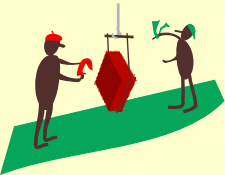|
Number103 — September 22, 2006
Action and Character
· Previous · INDEX · Next ·
Last week I quoted Ronald Tobias who divides plots into two broad general categories—Action and Character. This article defines those terms as I see them in the context of creative writing.
ACTION is decision and response.
CHARACTER is reaction and decision.
"A gross oversimplification," you say. Perhaps, but bear with me a moment while I explore the universality of my definitions. To do so, I ask you to consider your own behavior starting at this exact moment. I want you to keep reading this article until something else happens; let's suppose the telephone rings. Whether you realize it or not, you make a decision. You have several choices from simple to extreme: answer; not answer; ask somebody else to answer; disconnect the instrument; or ultimately cancel your telephone service and sue the company for disturbing your reading. So what do you do first? You make a DECISION and then you ACT.
In creative writing, the author must explain characters' decisions in such a way that the reader understands the decision and hence the subsequent action. In my ludicrous example, the first choice—to answer—may be inferred; a normal decision without conscious thought. But what if the character doesn't answer? Then the reader should be made aware of the emotional reaction that led to the decision because it is unusual, unexpected, or abnormal. Suppose robbers burst out of the bank on their way to an apparent successful getaway. The sheriff will have an emotional reaction before he makes a decision. Goldarnit, he left his gun belt in the office: can't shoot 'em. Drat; his horse is lame: can't ride it. Oh! Oh! Two women with a baby stand in the road, gossiping at the other end of town: does he have time to warn them? Only after he reacts mentally and emotionally to the situation in which he finds himself, can he act. The point is when the author explores and explains the thinking before the decision to act, the reader will accept the character—whether he acts in good faith or not—and the story will be better because the reader, who may or may not agree with the decision, will identify with the character. That is not to say readers like the character, but rather they understand characters they can identify with.
"I hate you," Sam said, glaring at Ellen. Now, what does Ellen do? She reacts emotionally. The reaction may take many forms, but it is emotional and should be described in emotional terms, not physical. Much harder for the author who, in many cases, skips over the emotional reactions because of not knowing how to describe them. My advice: STOP and figure them out. Initially, something goes on inside Ellen's head; Did he really say that? Is she dreaming? Is this the same man who took an oath to love and protect her? Next, come the irrepressible emotional reactions: shock; blood draining from her face, tears coming to her eyes, her hands beginning to tremble. Only after all this can a decision be made that will lead to action, which may be impulsive—she throws a plate at him—or may be rational—telling him to get out, or leaving the room herself. The point is Ellen's decision will be triggered by her emotional response, meaning what goes on inside her head that, in real time, may have taken only a second or two, but the author's exposure of her emotions could be sentences or paragraphs. After the emotion, and maybe days later, she makes her decision, which could demand more paragraphs or even pages of creative writing full of emotion to carry her from Sam's brash words through REACTION to DECISION to ACTION. Authors who cover such episodes in one sentence—she burst into tears and left the room—do an injustice to creative writing, to their characters, to the readers, and to themselves.
The moral is: make your characters' emotions identifiable and everybody will say; "The characters in your story are truly memorable." In terms of delivering reader enjoyment and appreciation, characters' beauty, grace, dignity, immorality, or any other good or bad attribute are less important than the emotions they experience. The important issue is the internal struggle your characters experience explains their decision, which, in turn, explains their action. Readers may or may not have experienced the same trauma as your characters, but when they can identify it, they will love your story. Therefore, the author must show mental torment to the readers. In doing so, the author often suffers mental torment, which is exactly what he tries to get on paper.
· Previous · INDEX · Next ·
|

